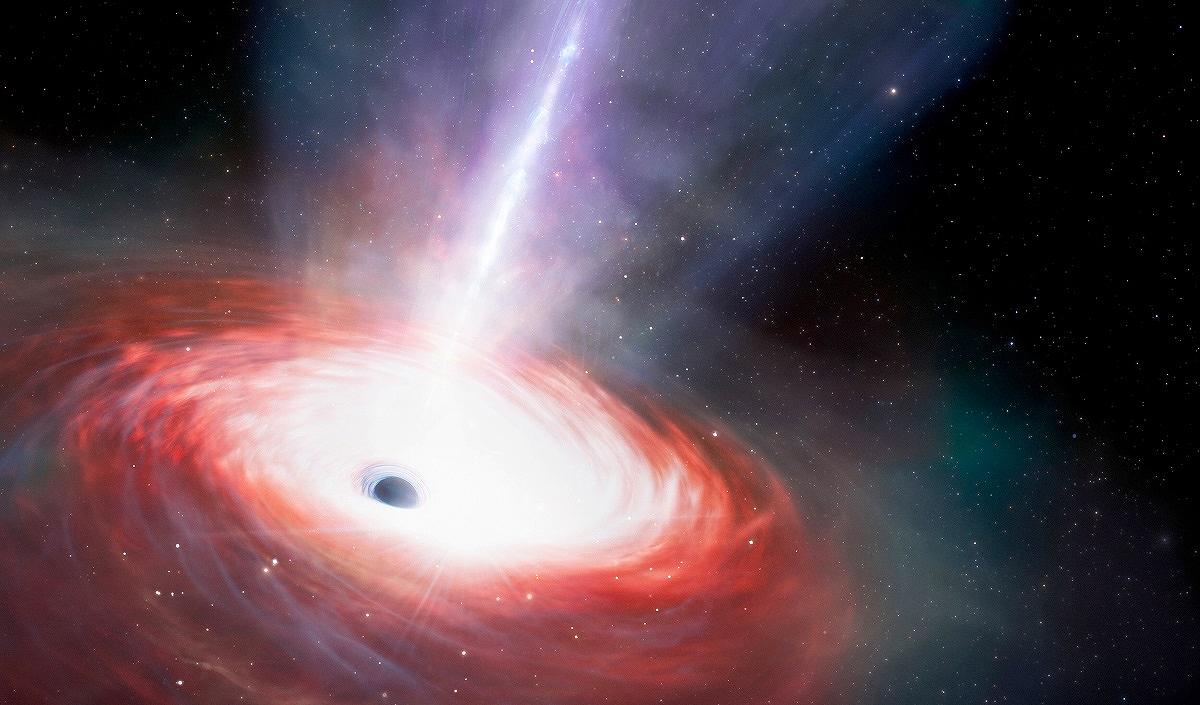
A rapidly feeding black hole that is emitting powerful gas outflows is seen in an artist’s image.
17:37 JST, November 14, 2024
WASHINGTON (Reuters) — At the heart of our Milky Way galaxy lurks a supermassive black hole about four million times the mass of the sun, called Sagittarius A*. In fact, these objects, which increase in mass over time by eating material that wanders too close, reside at the center of most galaxies.
But since NASA’s James Webb Space Telescope came online in 2022, astronomers have been surprised to find supermassive black holes inhabiting the early universe — earlier than they had thought possible considering the time needed to gather such great mass. New observations of one such primordial black hole is offering insight into how this may have occurred — through episodes of supercharged growth.
Black holes are extremely dense objects with gravity so strong that not even light can escape. With their immense gravitational pull, they grow in mass by sucking in material such as gas, dust and stars unfortunate enough to stray nearby.
“The existence of supermassive black holes in the early universe challenges our current models of black hole formation and growth,” said astronomer Hyewon Suh of the International Gemini Observatory in Hawaii and the U.S. National Science Foundation’s NOIRLab, lead author of the study published in the journal Nature Astronomy.
The new Webb observations involve a supermassive black hole called LID-568 that existed when the cosmos was about 11% its current age — about 1.5 billion years after the Big Bang event 13.8 billion years ago that initiated the universe. LID-568 has a mass about 10 million times greater than the sun, so 2½ times that of Sagittarius A*. The researchers have not yet determined the mass of its home galaxy.
LID-568 was observed gaining mass at a pace faster than previously thought possible. Webb showed that, based on its observed energetic output, LID-568 appeared to be consuming infalling material — known as accretion — at more than 40 times the hypothesized maximum, called the Eddington limit, for such activity.
“The Eddington limit is a theoretical limit for the maximum energy output the black hole can produce through the accretion process. This theoretical limit assumes that the outward force from the radiation produced during the accretion process balances the gravity of the infalling material,” said astronomer and study coauthor Julia Scharwachter of the Gemini Observatory and NOIRLab.
These primordial black holes are thought to have originated in one of two ways, either following the explosive death of the universe’s first generation of stars or through the collapse of large clouds of gas present in the early universe.
“The discovery of LID-568 suggests that a significant portion of mass growth can occur during a single episode of rapid accretion. This could help explain how supermassive black holes formed so early in the universe, regardless of how they originated,” Suh said.
“Until now, we have lacked observational confirmation of how these black holes could grow so quickly in the early universe,” Suh added.
A key sign of a growing supermassive black hole is emission of X-rays, high-energy electromagnetic radiation with very short wavelengths. Material swirling around a supermassive black hole before it is consumed is superheated and glows strongly in X-ray wavelengths. The researchers first spotted LID-568 using NASA’s Chandra X-ray Observatory and then studied it more closely using Webb’s infrared observational capabilities.
The Webb observations suggest the existence of some sort of mechanism through which a black hole can gobble up material at a faster pace than previously believed possible.
“LID-568 is remarkable due to its extreme growth rate and the fact that it exists so early in the universe,” Suh said. “We don’t know yet how LID-568 is able to exceed the Eddington limit. To investigate further, we need more data, so we are planning to conduct follow-up observations with Webb.”
"Science & Nature" POPULAR ARTICLE
-

Genome Study Reveals Milestone in History of Cat Domestication
-

Big Leap in Quest to Get to Bottom of Climate Ice Mystery
-

Security Camera Footage Vulnerable to Outside Access; Investigation Finds 3,000 Pieces Exposed Online
-

Japan Set to Participate in EU’s R&D Framework, Aims to Boost Cooperation in Tech, Energy
-

Paws on Parade: Nairobi’s Dogs Dazzle at ‘Pawchella’
JN ACCESS RANKING
-

Tokyo Economic Security Forum to Hold Inaugural Meeting Amid Tense Global Environment
-

Keidanren Chairman Yoshinobu Tsutsui Visits Kashiwazaki-Kariwa Nuclear Power Plant; Inspects New Emergency Safety System
-

Imports of Rare Earths from China Facing Delays, May Be Caused by Deterioration of Japan-China Relations
-

University of Tokyo Professor Discusses Japanese Economic Security in Interview Ahead of Forum
-

Japan Pulls out of Vietnam Nuclear Project, Complicating Hanoi’s Power Plans






















